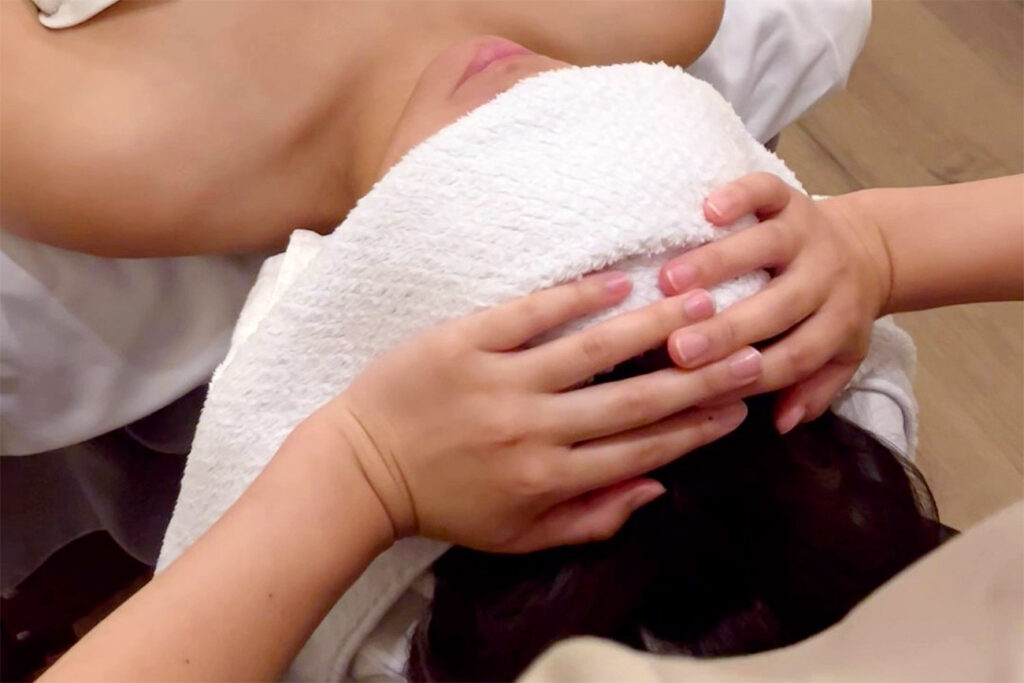In massage therapy, holding is more than just a technique—it is a practice that brings deep relaxation to both body and mind. This article explains holding in detail, from its basic principles and applications to its remarkable effects.
- [Tsubaki Massage Technique 1] What Is Petrissage?
- [Tsubaki Massage Technique 2] What Is Kneading?
- [Tsubaki Massage Technique 3] What Is Effleurage?
- [Tsubaki Massage Technique 4] What Is Friction?
- [Tsubaki Massage Technique 5] What Is Holding?
What Is Holding? Basics and Importance
Definition and Purpose of Holding
Holding is a relaxation technique used in massage and therapy, where the practitioner gently places their palms or finger pads on the client’s body—most commonly on the head—creating a sense of being enveloped. By resting the hands softly on the entire body or specific areas, it provides a feeling of safety and comfort, promoting deep relaxation.
The duration and pressure of holding are adjusted according to the client’s condition and purpose, helping create an environment where the client can relax completely.
Key Points for Effective Holding
There are several important points to consider for proper holding. First, use your entire palm to make contact with the client’s body. Rather than just touching with the fingertips, use your whole palm to gently embrace the area, which helps the client feel secure. The purpose of holding is not to apply pressure, but to support gently and enhance relaxation.
Synchronizing breathing between practitioner and client further deepens relaxation. Match your movements to the client’s breath, supporting their body slowly and rhythmically.
Benefits of Holding
Holding provides multiple benefits for both body and mind. Physically, it helps relieve muscle tension, promote blood flow, and ease pain. As muscles relax and circulation improves, physical discomfort diminishes naturally.
Holding Techniques by Body Area: Shoulders, Back, and Head

Shoulder Holding: Easing Shoulder Stiffness
Shoulder holding is effective for relieving stiffness caused by desk work or smartphone use. It’s especially beneficial for those experiencing tightness in the shoulders or neck.
The practitioner gently places both hands on the client’s shoulders, wrapping them softly. Use the entire palm, not just fingertips, and apply even, gentle pressure.
This technique can be used on its own or combined with others, such as scapular release or neck massage, to enhance results.
Back Holding: Relieving Lower Back Pain
Back holding is effective for easing lower back tension. It is particularly helpful for people who spend long hours sitting or standing, which strains the lumbar area.
The practitioner gently places their hands on the client’s back, covering the area with both palms evenly. Focus around the lumbar and sacral regions, supporting them softly rather than applying force.
Head Holding: Alleviating Headaches
Head holding is an excellent technique for reducing tension headaches.
The practitioner places their hands around the client’s head, gently encompassing it. Apply slow, steady pressure from the ears toward the nape of the neck. The ideal holding duration is about 5–10 minutes.
Encourage the client to take deep breaths, releasing tension with each exhalation to maximize relaxation.
Three Major Effects of Holding

Deep Relaxation and a Sense of Safety
Holding provides a profound sense of calm and safety. The gentle, enveloping touch evokes feelings similar to being embraced by a parent, easing both mental and physical tension.
This state of relaxation activates the parasympathetic nervous system, lowering heart rate and blood pressure. It also encourages alpha and theta brain waves, deepening the state of restfulness.
Integration of Body Awareness
Holding helps integrate body awareness. In daily life, we tend to focus on external stimuli such as sight and sound, but holding directs attention inward. Gentle touch stimulates sensory receptors in the skin, sending signals to the brain that enhance awareness of body position and state.
It also stimulates the sensory input from muscles and joints, improving posture and balance. As body awareness becomes more integrated, people often develop greater self-recognition and care for their physical well-being, leading to healthier habits.
Balancing the Flow of Energy
Holding is believed to balance the body’s flow of energy. In Eastern medicine, “Qi” (life energy) flows through the body, and stagnation of this energy is thought to cause discomfort or illness. By gently touching specific areas, holding helps restore the smooth flow of Qi and balance the body’s overall energy field.
For example, the head contains many acupressure points, and holding the head can help regulate energy throughout the entire body.
